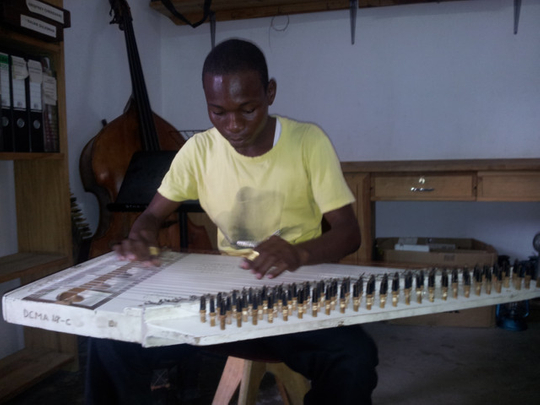
“Tears of love, flowing down my face
Can’t eat, get satisfied and be happy
The love of my life has left me ...”
-Siti Bint Sa’ad (1880-1950)
Unbeknownst to her, Siti Bint Sa’ad became the first female proponent — and arguably one of the most famous singers — of a music genre that is unique to the Swahili coast of East Africa.
Taraab (also known as tarabu) is an Arabic word which means music. While taraab is popular across East Africa, its spiritual home remains Zanzibar, a semi-autonomous island off the coast of Tanzania. Any person from the Arab world or the Indian subcontinent listening to taraab will immediately identify with it — the music is a fusion of rhythmic Swahili notes and Arab and Indian tunes. And in many ways, this fusion reflects the ethnic and cultural melting pot that is Zanzibar — whose people are an intriguing combination of Africans, Indians, Omanis and Shirazis from Iran, and speak Swahili as their mother tongue.
Perhaps the best description of taraab was provided by American researcher John S. Roberts, who noted: “Like most complex and living things, in fact, Tarabu refuses to be thrust into neat bags. It is an extremely lively art form [that] springs from a classical culture, still immensely popular, drawing all the time from old and new sources, a major part of social life of the Swahili people.”
Siti Bint Sa’ad has been compared to Egyptian diva Umm Kaltoum and Indian legend Lata Mangeshkar. Indeed, some taraab songs are reminiscent of Bollywood melodies of the 1950s. She travelled up and down the Swahili coast for live performances, and even headed out to faraway Bombay (present-day Mumbai) to record the first commercial taraab album, as such facilities were unavailable then in sub-Saharan Africa.
It is believed that taraab was introduced to Zanzibar by Sultan Sayyid Barghash Bin Said (1870-1888), a ruler who had a weakness for the finer things in life. He brought a group of Egyptian musicians to his court for his own entertainment and that of his guests. Barghash later sent a Zanzibari musician to Cairo to study music, and upon his return in 1905, the musician set up Nadi Ikhwan Safa’a (“brothers who love one another”), one of the oldest orchestras in Africa, which is active to this day.
“Taraab was welcomed in Zanzibar and the people here tried to give it deeper meaning. Zanzibaris added Swahili to it — hence taraab here is different because of the language and the interpretation people here put into it,” said Mohammad Othman Faqih, a taraab expert. We meet at the famous Dhow Countries Music Academy in Stone Town, Zanzibar, where Faqih is a musician and a teacher. The academy was started to revive interest in taraab among the youth. “Before taraab, Zanzibaris had rhythms we called Misewe and Beni. The sultan [Barghash] developed such a fondness for taraab music that he invited groups from Egypt to play at his court. He can be credited with introducing taraab here.”
Faqih said the scales used in taraab are the same as those in Arabic music. As for the instruments, oud, kanun, violin and Arabic tabla are mainly employed. “If it is just an instrumental, it is still taraab, but there is a name for it — bashraf. Taraab has a very obvious influence of India and the Arab world, especially Egypt.”
He believes that the Zanzibar government’s efforts at promoting the genre have been “very limited”. “They are preoccupied with contemporary issues. Culture and music have taken a back seat. Our academy has to mainly rely on Norwegian grants. We have to find money to run it, one way or the other.”
Benito Bauser Mwangaza, a 21-year-old German citizen of Tanzanian origin, and a student at the academy, said that he had come here to learn the music of Tanzania. “At first, I found taraab to be too Arabic. It was not what I associated Tanzanian music with. But with time, I have come to love it. Now I feel it is becoming a part of me.”
While there seems to be growing interest in taraab music among the Swahili diaspora, young people in Zanzibar itself apparently don’t appreciate it much. “I am very pessimistic about the future of taraab in Zanzibar. It’s slowly dying. The youth are learning piano, keyboard and other Western instruments. They are more interested in Western music. They seem to prefer rap and hip hop to taraab. That is a tragedy,” Faqih said.
Zuhura Swaleh, a famous taraab singer from Mombasa, Kenya, has explained it thus: “There is a lot to be gained from taraab. Because taraab discusses the life of human beings in every way, such as to help a person to get over the grief when someone has died. There are other [taraab] songs that may calm your soul by showing you that everything that happens in your life is arranged by God ... There are taraab songs for comfort, showing you that it is not only you who is in trouble, it is this world. There are love songs, comical songs ... Taraab songs are really a collection of all different kinds of things in the life. Taraab is an explanation of life. This is its value.”


